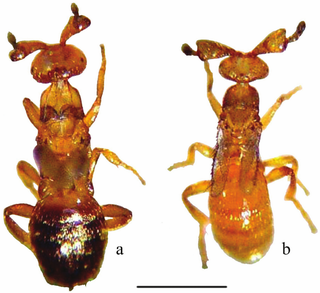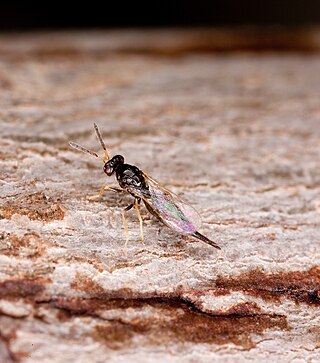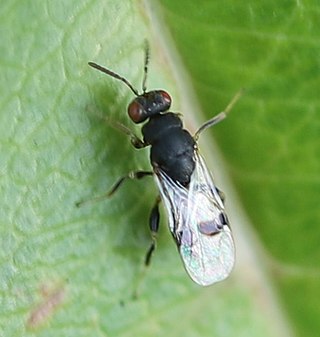
The Eulophidae is a large family of hymenopteran insects, with over 4,300 described species in some 300 genera. The family includes the genus Elasmus, which used to be treated as a separate family, "Elasmidae", and is now treated as a subfamily of Eulophidae. These minute insects are challenging to study, as they deteriorate rapidly after death unless extreme care is taken, making identification of most museum specimens difficult. The larvae of very few species feed on plants, but the majority are primary parasitoids on a huge range of arthropods at all stages of development. They are exceptional in that they are one of two hymenopteran families with some species that are known to parasitize thrips. Eulophids are found throughout the world in virtually all habitats.
Kiggaella is a genus of hymenopteran insects belonging to the family Eulophidae. There is just one described species, Kiggaella oryzae, only known from rice paddies in Karnataka and Kerala states, India.
Agmostigma is a small genus of hymenopteran insects of the family Eulophidae which contains three species, all described in 1996 by Ubaidillah and LaSalle and so far only recorded from Brunei in northern Borneo.
Aprostoporoides is a small Indomalayan genus of hymenopteran insects of the family Eulophidae which was described in 2004 with two newly described species from Kerala.
Baeoentedon is a genus of hymenopteran insects of the family Eulophidae, they are parasitoids of whitefly from the family Aleyrodidae which are found on trees of the genus Ficus. They have been recorded from Australia, China, India, Indonesia and Florida. A fifth species, Baeoentodon farazi, was described from Karnataka, India, in 2017.
Chrysonotomyia is a genus of hymenopteran insects of the family Eulophidae.

Colpoclypeus is a genus of hymenopteran insects of the family Eulophidae.
Emersonella is a genus of hymenopteran insects of the family Eulophidae. Several species are known to be phoretic parasitoids of female tortoise beetles, laying their eggs in the eggs of the beetle host.
Eprhopalotus is a genus of hymenopteran insects of the family Eulophidae. Their distribution varies between species but ranges from Costa Rica, Mexico to Texas. There are currently 5 species of Eprhopalotus:
Goetheana is a genus of hymenopteran insects of the family Eulophidae. As a parasitoid of thrips, this wasp is used in biological pest control.
Kolopterna is a genus of hymenopteran insects of the family Eulophidae. Kolopterna comprises 14–15 species distributed in the Palearctic and Oriental regions All Kolopterna species are endoparasitoids of gall midges causing galls on various Chenopodiaceae.

Melittobia is a genus of hymenopteran insects of the family Eulophidae.

Minotetrastichus is a genus of hymenopteran insects of the family Eulophidae. They are parasites of leaf-mining Lepidoptera, Coleoptera, and Hymenoptera.
Neotrichoporoides is genus in the family Eulophidae, containing approximately 70 species.
Notanisomorphella is a genus of hymenopteran insects of the family Eulophidae. They are parasitoids with hosts including Coleophoridae, leaf mining beetles, and spider eggs.

Pnigalio is a genus of hymenopteran insects of the family Eulophidae. Nearly 100 species have been described of which about half may be valid. All species are parasites of other insects. Their biology varies widely among those species that have been studied. Some are ectoparasites, others parasitoid, and still others are hyperparasitoids and their hosts include beetles, flies, hymenopteran and lepidopterans.

Quadrastichus is a genus of hymenopteran insects of the family Eulophidae.

Tetrastichus is a genus of hymenopteran insects of the family Eulophidae.
Inti levis is a species of insect in a monotypic genus in the family Eulophidae. It was discovered in Costa Rica and the Dominican Republic in 2010 by Christer Hansson.

Sycophila is a genus of wasp that associates with figs and galls of various insects such as gall wasps and gall midges. They have a cosmopolitan distribution.







